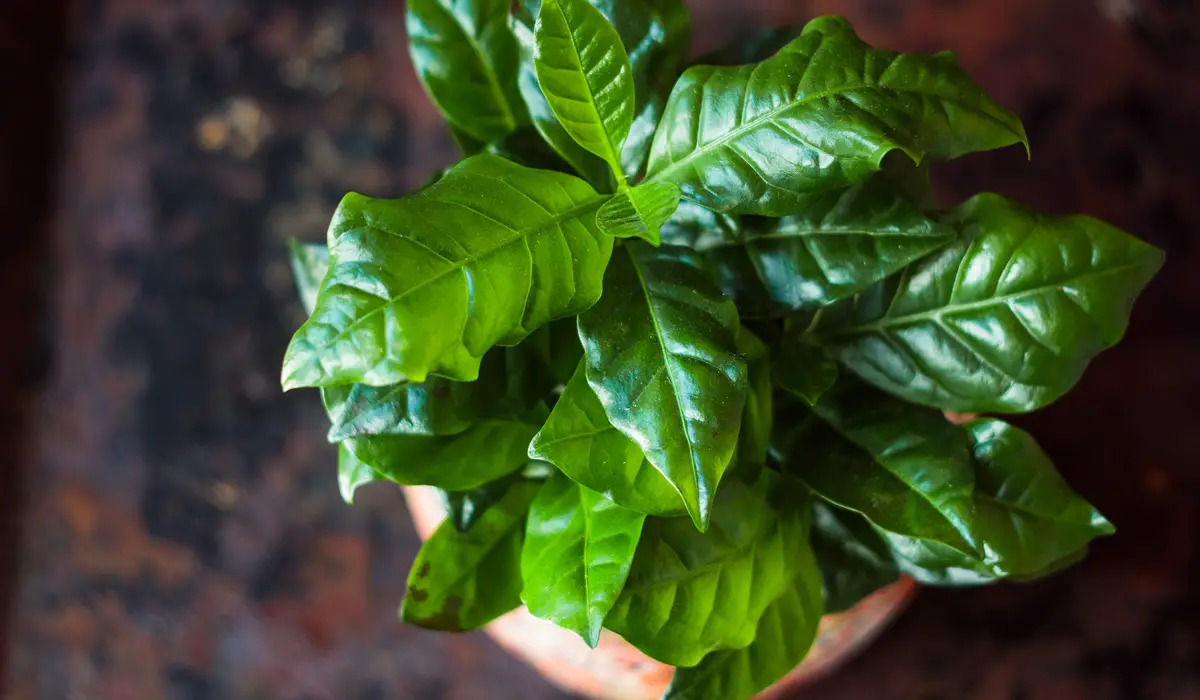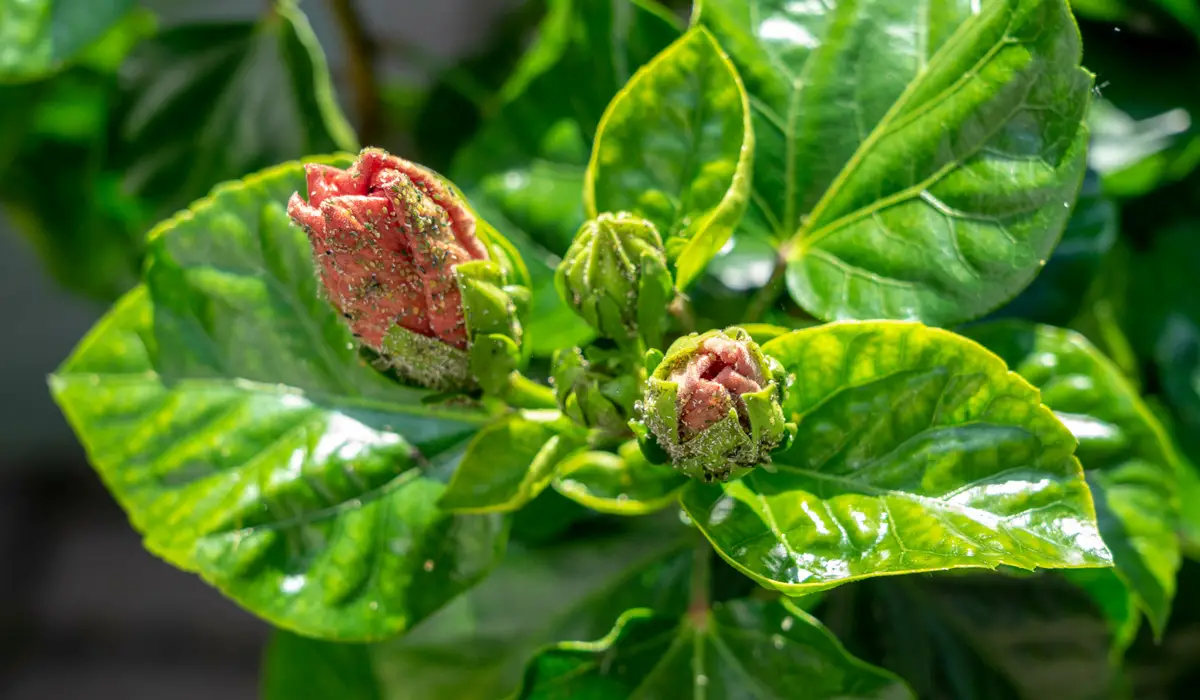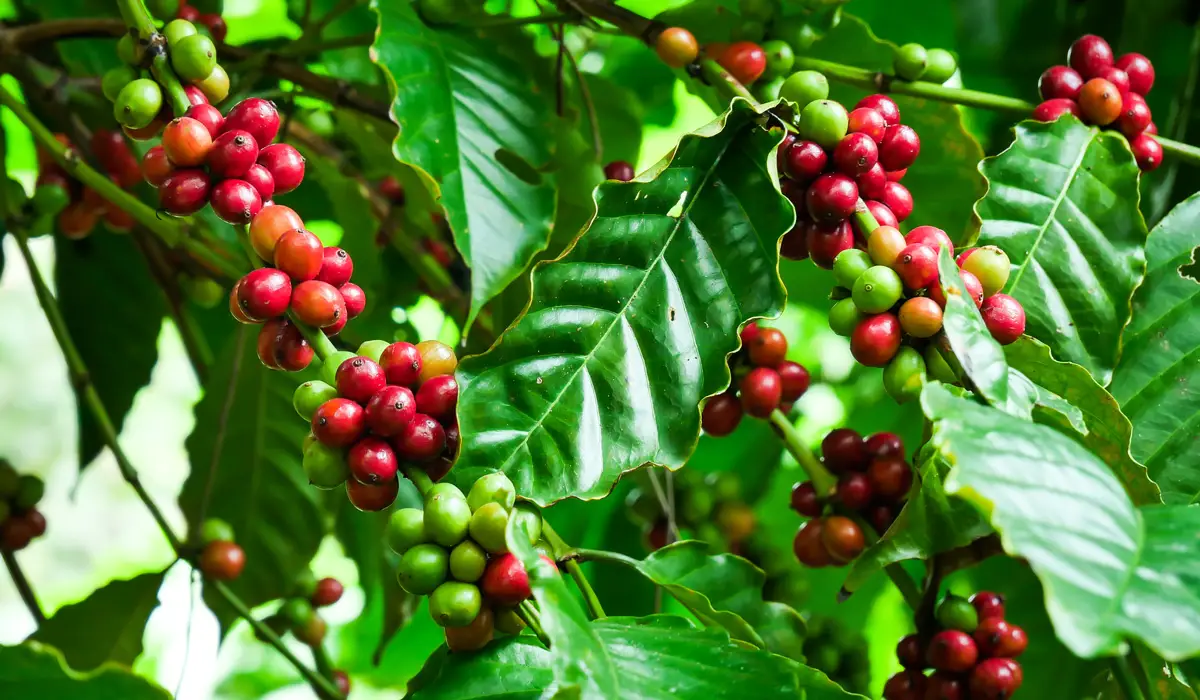How to Grow and Care For an Arabica Coffee Plant: Follow These Easy Steps

This post follows our research editorial guidelines.

There are few plants as critical to my success as a gardener than coffee trees! While most of that support comes in the form of thick, rich lattes and the occasional reviving macchiato, they also serve as a surprisingly beautiful houseplant. If you love the wide, textured leaves of fiddle-leaf figs but struggle to keep their temper tantrums under control, maybe a coffee tree is the right one for you.

Table of Contents
What Is a Coffee Plant?
Coffee plants are small evergreen trees native to North Africa. They have broad, glossy green leaves and develop richly fragrant white flowers through the spring and summer. Once fertilized, the flowers ripen into small clusters of purple or red berries. While the plant itself makes for an attractive house plant, it’s the ruby bright cherries that have made coffee plants so popular world wide.
“Reaching a height of 15 feet, coffee tree is a great conversation piece, growing in light rich soil and partial shade. Regular pruning can keep the plant attractive at any desirable size. This handsome shrub is suitable for containers, specimen plantings, or used as a small understory tree in hammocks and wild wooded areas.”
Edward F. Gilman, professor, Environmental Horticulture Department, University of Florida
How do you take care of a Coffee plant?
Coffee plants are tropical species and need consistently warm temperatures. They’ll only grow outdoors in UDSA Hardiness Zones 10B to 12B – the very southern tip of Florida, and the warm islands to the south. Grown outdoors in these areas they can largely be left to their own devices. They aren’t fussy about soil and as long as you plant them in dappled shade they’ll thrive. It’ll take three to five years before they mature and the plant produces its first flowers and fruit.
For most folks, growing coffee plants indoors is the most reliable way cultivate these elegant plants. Coffee plants don’t like the cold and are not even remotely frost resistant. If you want to grow your own coffee plant inside you’ll need to pay a bit more attention and learn how to care for its specific needs. It’s worth the effort – a coffee plant makes a charming talking point and interior feature.
| Botanical Name | Coffea arabica |
| Growth Rate | Fast, mature at 4 years |
| Blooming period | Late spring early summer |
| Hardiness Zones | 10B through 12B |
| Light | Part shade/part sun outdoors; bright light indoors |
| Soil Needs | Rich, well draining soil, low salt tolerance. Acidic to neutral pH |
| Temperature | 15-24°C (60-70°F) |
| Ease of Care | Moderate |
| Diseases | Coffee leaf rust, Brown eye spot disease, Black rot |
| Propagation | From seeds or cutting |
| Fertilizer | Balanced acidic blend (10-10-10) |
| Pests | Pest Resistant |
| Humidity | High |
| Pruning | To maintain shape as needed. |
| Water needs | High, water deeply and frequently outdoors; maintain moist soil in containers. Weekly watering for indoor plants once the top inch of soil is dry to the touch |
How much light does a Coffee Plant need?
Coffee trees thrive with bright, indirect light and lots of it. They’ll do well placed near a window, preferably south facing. Direct sunlight on their leaves can cause sun damage. This shows as leaves that are pale or bleached at first, before they turn brown or develop brown spots. Make sure they’re set far enough back to benefit from all that good light safely without full sun striking their foliage.
How Often Should a Coffee Bean Plant be Watered?
Coffee plants need soil that is moist but not waterlogged. Water regularly to ensure the soil remains moist without being too soggy. In summer this may be once or twice a week, with less water needed during the cooler months. If they dry out the leaves and stems will wilt – they’ll let you know if you need to water!
They also need high humidity – too little results in brown leaf tips. Misting the leaves once a day will help, and a pebble tray helps too. This is a saucer or dish with a layer of stones at the bottom. Put enough water in the saucer to cover the stones, and it evaporates for gentle local humidity. You can also just cut to the chase and give this charming evergreen plant a small electric humidifier to call its own.
What’s the Best Temperature for a Coffee Plant?
When grown as a houseplant, coffee plants need temperatures much the same as we do. Aim for consistent temperatures of around 15-24°C (60-70°F). During summer you can take them out to shaded porches for a little holiday, but be sure to get them back indoors before the weather turns.

What Is The Best Soil and Pot for Coffee Plants?
Coffee plants prefers a rich, loamy soil that holds water well but doesn’t become boggy. You can achieve this by ensuring both the soil and the pot drain well.
I amend my potting mix blends with a good dose of perlite. Commonly used in hydroponics, it’s an airy material that provides good drainage and structure to soils. It also holds fertilizer well and will provide excellent support for your coffee plant.
As for your pot, wider is better. Coffee has a broad but shallow root system and the plant can reach only the moisture and nutrients towards the top of the pot. Make sure it has at least three good sized drainage holes, too. This will stop water stagnating at the bottom of the pot and guard against root disease.
Do I Fertilize my Coffee Arabicia?
Coffee plants do well with the same sort of organic high nitrogen fertilizer you’d use for roses or citrus. Well rotted manures, guano and fish emulsions are ideal. Avoid using synthetics – coffee plants are sensitive to salts, even those found in fertilizers.
Diseases and Pests of Arabica Coffee Plants
Commercial coffee plantations have a host of diseases and pests that afflict them, but this is largely due to high density plantings. If you grow a coffee plant all by itself indoors you won’t face the same level of trial and tribulation. Watch out for the usual suspects of thrips, aphids, scale and spidermites, and make sure to give your coffee plant adequate ventilation to protect against leaf diseases.
Propagating Coffee Plants
Coffee plants propagate with little effort. It’s so easy that they’ve become a weed in many former growing regions.
Soak fresh green seeds still in their parchment overnight then plant directly into a seed raising medium. Keep them warm and moist, and they’ll pop up anywhere from four weeks to six months later.
Cuttings are even faster. They can be grown from softwood cuttings with the help of a little rooting hormone. Cuttings should be 5mm across the stem. Once carefully split and generously dosed with rooting hormone they can be planted in a tub of seed raising medium. Seal them into a clear bag to provide extra humidity while they root.
How to Harvest Coffee Berries and Prepare Coffee Beans

The coffee cherries from your plant will be ready to harvest once they have changed color from green to red. Here’s how to process coffee fruit into delectable beans.
Step 1: Harvest and Remove Pulp.
Pick red, ripe berries and remove the pulp. You can use a cherry pitter or squeeze the fruit until the seed is free. They are small yellow-green pits, with 1 to 2 per berry.
Step 2: Remove Slime.
Put the seeds in a plastic container and cover with water. In day or two friendly microbes will devour the slime and leave only the clean seed behind. Once the seed feels rough instead of slimy, it’s ready to wash and dry.
Step 3: Dry and De-husk the Beans
Rinse the beans with clean water. Next, spread the beans on a large tray or pan and dry them in a warm, dry location. Once dry, remove the papery parchment layer that surrounds the bean.
Step 4: Roast!
Green beans will store for months without problems if kept in a cool, dry place. But to get them ready for brewing they’ll need to be roasted.
Place the beans in a dry wok or large pan on a medium heat. Keep the seeds moving as they warm up and change colors. The longer you roast the bean, the darker the grounds and the stronger the flavor. You can also roast in an oven if you prefer. A single layer of beans placed in hot oven 230-250°C(446-482°F)will take 12 minutes to reach a medium roast.
Once roasted lay them out flat to cool. Remove beans that are paler or darker than average. Once cool they will store well for months, especially if placed in a freezer.
FAQ
Can You Grow A Coffee Bean Tree Indoors?
If you make sure you care for a coffee plant, it’ll do just fine indoors. They won’t grow as fast, and remain a much more compact tree. You’ll also need to provide enough light, water well and prune aggressively. If you care for your coffee plant well, it can live for 25 years or more.
How tall does Arabica coffee plant grow indoors?
Coffee plants are trees, and with the right care can reach upwards of 5 meters and about half again across. That’s 16 feet tall and 8 feet wide for those of you to the south. Pruning is the most effective way to restrict their height. Cutting the whole top off while the plant is young encourages a lot of lateral growth, and you can cut the plant back even further as it matures.
How to Get Coffee Plant to Bloom
Get your coffee plant care just right and it will reward you with flowers. You have to get your care regime absolutely perfect and it’ll take a few years. Keep the soil moist but not soggy, so make sure you pot your coffee plant in rich soil that drains well. They grow in dense clusters of 2-10 fragrant white flowers, grouped in bunches towards the ends of the branches. Flowers on any indoor plant are an achievement, worthy of celebration!

Before you go!
10 Benefits of Air Plants Indoors
How To Tell If Your Air Plant Is Dying? + Ways To Revive
6 Benefits of Snake Plants – And How They Can Boost Your Mood
How Long Does a Tomato Plant Live?